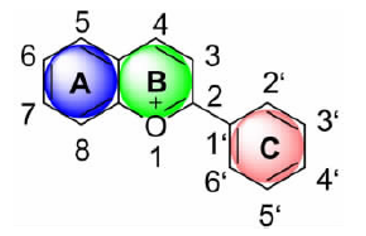Introduction
Anthocyanin is a natural product with the potential to be used as a cyanine fluorescent dye. The structure shown in Figure 1 is the basic structural unit of anthocyanins, a class of compounds with a flavonoid nucleus as parent, which is mainly composed of two benzene rings and an oxygen-containing heterocyclic ring. These compounds have been widely used in food coloring, medicine, cosmetics and other fields, especially as fluorescent dyes for fluorescent probes.
 Fig. 1 The structure of anthocyanin
Fig. 1 The structure of anthocyanin
Application
With the development of research, cyanine fluorophore and its derivatives have been used in exploring Dye-sensitized solar cell, textile, probe and other fields.
- Dye-sensitized solar cell (DSSC): DSSC, a new type of solar cells, have attracted worldwide attention because of their advantages of low cost, easy preparation and environmental protection. Dye sensitizers are divided into two major categories-organic dyes and metal-organic compounds, cyanine fluorophore is one of the organic dyes. Sayama [1] has synthesized a series of cyanine fluorophores containing carboxyl groups and long alkyl chains to explore the factors affecting the photoelectric conversion efficiency and it provides a good reference for its future application.
- Textile fluorescent dyeing: Fluorescence dyes are a kind of functional dyes with great application prospect and have attracted attention of many scholars due to their high emission intensity, bright color and strong fluorescence. Half-cyanine fluorophore-based dyes have been Optimization to achieve better with the application. Qin [3] synthesized a Half-cyanine fluorophore-based dyes (see Fig.3) and applied it to acrylic fabric dyeing.
- Fluorescence probes: Cyanine-based fluorescent probes locate at near-infrared areas, endowing themselves with strong penetration capability and low interference from biological auto-fluorescence, and consequently they are commonly used in chemical biological analysis, especially in vivo imaging. Cyanine fluorophores have adjustable methylidyne chain, of which the longer heptamethyl cyanine has a good near-infrared region of maximum absorption and fluorescence emission and has a very good effect in the cell and in vivo level imaging fluorescent molecular probes. Han [4] designed a probe to monitor intracellular oxygen pressure of H2O2 and reductive repair of glutathione (GSH) by adding a dopamine switch to the heptamethyl cyanine fluorophore.
 Fig. 2 Working principle of DSSC [2]
Fig. 2 Working principle of DSSC [2]
 Fig. 3 Half-cyanine fluorophore-based dyes
Fig. 3 Half-cyanine fluorophore-based dyes
 Fig. 4 Mechanism diagram of cyanine fluorescence probe for monitoring H2O2 and GSH
Fig. 4 Mechanism diagram of cyanine fluorescence probe for monitoring H2O2 and GSH
References
- Sayama K.; et al. Photosensitization of a porous TiO2 electrode with merocyanine dyes containing a carbonyl group and e bns alkyl chain. Chem Commun, 2000 (13): 1173.
- Deng Y.; et al. Application and research progress on organic dyes sensitizers used in dye-sensitized solar cell. China Academic Journal Electronic Publishing House, 2016, 30(5): 24-29.
- QIN.; et al. Dyeing properties and colour characteristics of a novel fluorescent dye applied to acrylic fabric. Fibres & Textiles in Eastern Europe, 2013, 21(4): 144-147.
- Yu F B.; et al. Facilitative functionalization of cyanine dye by an on–off–on fluorescent switch for imaging of H2O2 oxidative stress and thiols reducing repair in cells and tissues. Chemical Communications, 2012, 48(41): 4980-4982.










